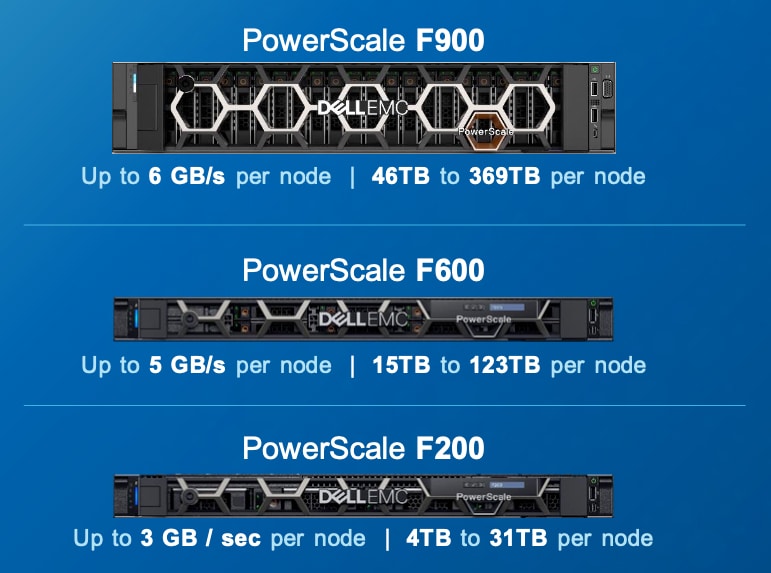Today Dell Technologies announced updates to its PowerScale line. These updates include a new unit, the Dell EMC PowerScale F900 that is an all-NVMe shelf for the most demanding workloads. The company is also updating the operating system with OneFS 9.2, which aims to bring more performance to the existing F200 and F600 as well as more security for the entire line.
Today Dell Technologies announced updates to its PowerScale line. These updates include a new unit, the Dell EMC PowerScale F900 that is an all-NVMe shelf for the most demanding workloads. The company is also updating the operating system with OneFS 9.2, which aims to bring more performance to the existing F200 and F600 as well as more security for the entire line.

Dell Technologies first announced PowerScale in June of last year. PowerScale combined the company’s storage software with its server hardware. Dell EMC did this by using the OneFS operating system that was previously more well known as the OS in their Isilon. Dell EMC PowerScale was designed with unstructured data in mind. The company claims that PowerScale has several benefits including scaling without disruption, intelligent automation, programmable infrastructure, deployment flexibility, and multi-cloud support.
Dell EMC PowerScale F900
The first major change to PowerScale is the addition of the Dell EMC PowerScale F900. The F900 brings all-NVMe storage to PowerScale. It comes in 2U blocks with 24 NVMe SSDs allows from 46TB to 368TB per node and up to 93PB of raw capacity per cluster. The F900 feature dual Intel Cascade Lake processors and is aimed at M&E 8K, genomics, algorithmic trading, AI, ML, and HPC. The F900 is added into the existing F600, F200, Isilon F800, and Isilon F810.
Dell EMC PowerScale F900 key specifications
| NVMe SSDs | 1.92TB | 3.84TB | 7.68TB | 15.36TB |
| Raw node capacity | 46TB | 92TB | 184.3TB | 368.6TB |
| NVMe SSD Non-SED drives (2.5″) per node | 24 | |||
| CPU type (per node) | Dual socket Intel Cascade Lake Processor | |||
| ECC memory (per node) | 736 GB | |||
| Front-end networking (per node) | Dual-port 25G NIC supporting 10G or 25G connections (SFP+/SFP28) Dual-port 100G NIC supporting 40G or 100G connections | |||
| Infrastructure networking (per node) | 2 InfiniBand connections with QDR links or Dual-port 100G NIC supporting 40G or 100G connections (QSFP+/QSFP28) | |||
| Max Power Consumption @ 200~240V (per node) | 859 Watts (@25°C) | |||
| Typical thermal rating | 2931 BTU/hr | |||
Another interesting facet of the new Dell EMC PowerScale F900 is that you can mix and match it into a cluster to get the performance and capacity that you need. It is also compatible with existing Isilon clusters. Like the F200 and F600, the F900 also features inline data reduction and post-process deduplication. F900 supports NVIDIA GPUDirect as well.
OneFS 9.2
The OS, OneFS got what Dell calls, a little bit more than just a check the box upgrade. The top benefit of the update is performance. The company claims that the F200 node sees a 25% spike in performance and the F600 node can see up to a 70% increase in sequential reads. The new update supports NFS over RDMA (this extends to any PowerSclae or Isilon node with 40GbE interfaces) this is particularly important for customers with GPU-powered applications but will benefit just about any customer. Version 9.2 brings security updates with IPv6, external key manager support, and STIG.
And since everyone is getting on the cloud bandwagon, there is a new all-flash tier for Dell EMC PowerScale for Google Cloud. The new offering is available now with Tier 1 Agile configurations. This is a good option for those looking to get in on the all-flash end of PowerScale without the upfront costs of purchasing the above.
Engage with StorageReview
Newsletter | YouTube | LinkedIn | Instagram | Twitter | Facebook | TikTok | RSS Feed
